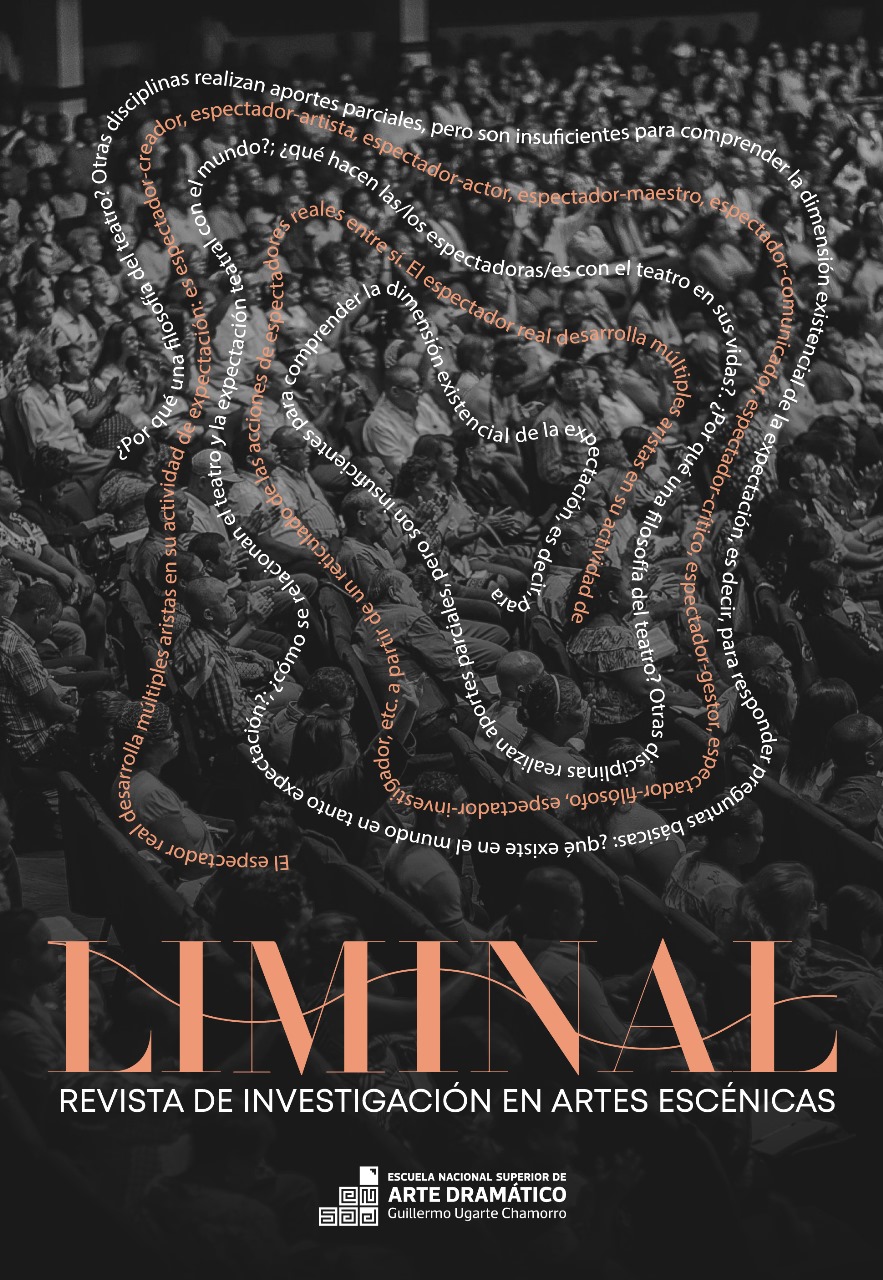La transformación del espectador
explorando al espectador activo en el paradigma cognitivo 4E
DOI:
https://doi.org/10.69746/liminal.a17Keywords:
Cognitive sciences, neurosciences, 4E cognition, autopoiesis, communicationAbstract
Assuming the complexity of the human mind and the cognitive process in which it participates, this article is interested in analyzing its activation in the spectator of a theatrical performance when capturing and processing the information transmitted from the stage. To do so, it draws on some of the theoretical arguments provided by the cognitive sciences and neurosciences, fields of study that use vocabulary and concepts with which to understand sensory and nervous activation, emotional interpretation, the construction of meaning, the connection with the performers and finally the cognitive process from which meaning, and experience emerge. In the analysis conducted, this information is presented through the lens of 4E cognition, an interdisciplinary approach to the study of human cognition that moves away from the traditional mind-centered focus by considering the emergence of thought and cognition as a phenomenon arising from the interaction between the brain, the body, and the environment. Similarly, autopoiesis is introduced and applied, a notion migrated from biology that refers to the capacity of living systems, read performers and spectators of a theatrical performance, to produce and maintain themselves. It will be concluded that the spectator in his role as receiver is active, in the sense that the information he processes is unique and non-transferable in a two-way communication space in which there is not one sender for three hundred receivers but three hundred interpretations of a single representational process.
Downloads
References
Batlle, C. (2020). El drama intempestivo. Hacia una escritura dramática contemporánea. Paso de Gato.
Clark, A. (2016). Surfing Uncertainty: Prediction, Action, and the Embodied Mind. Oxford University Press. DOI: https://doi.org/10.1093/acprof:oso/9780190217013.001.0001
Cross, E. y Hamilton, A. (Eds.). (2018). The Neurocognition of Dance: Mind, Movement and Motor Skills. Psychology Press.
Damasio, A. (2018). The Strange Order of Things: Life, Feeling, and the Making of Cultures. Vintage Books.
Depraz, N., Varela, F. y Vermersch, P. (Eds.). (2003). On Becoming Aware: A Pragmatics of Experiencing. John Benjamins Publishing Company. DOI: https://doi.org/10.1075/aicr.43
Di Paolo, E. (2008). Extended life. Topoi 28, 9-21. DOI: https://doi.org/10.1007/s11245-008-9042-3
Eagleman, D. (2021). Livewired: The Inside Story of the Ever-Changing Brain. Pantheon Books.
Fields, R. (2021). Electric Brain: How the New Science of Brainwaves Reads Minds, Tells Us How We Learn, and Helps Us
Change for the Better. BenBella Books.
Gallagher, S. (2017). Enactivist Interventions: Rethinking the Mind. Oxford University Press. DOI: https://doi.org/10.1093/oso/9780198794325.001.0001
Gallagher, S. (2012). Phenomenology (2ª ed.). Palgrave Macmillan. DOI: https://doi.org/10.1057/9781137283801
Gallese, V. y Lakoff, G. (2005). The Brain’s Concepts: The Role of the Sensory-Motor System in Conceptual Knowledge. Cognitive Neuropsychology, 22(3-4), 455–479. DOI: https://doi.org/10.1080/02643290442000310
Gazzaniga, M., Ivry, R. y Mangun, G. (2018). Cognitive Neuroscience: The Biology of the Mind (5a ed.). W. W. Norton
& Company.
Gibson, J. (1979). The Ecological Approach to Visual Perception. Houghton Mifflin.
Goffman, E. (1956). The Presentation of Self in Everyday Life. University of Edinburgh. https://monoskop.org/images/1/19/Goffman_Erving_The_Presentation_of_Self_in_Everyday_Life.pdf
Iacoboni, M. (2009). Mirroring People: The Science of Empathy and How We Connect with Others. Picador.
Kahneman, D. (2011). Thinking, Fast and Slow. Farrar, Straus and Giroux.
Kershaw, B. y Nicholson, H. (2011). Research Methods in Theatre and Performance. Edinburgh University Press. DOI: https://doi.org/10.1515/9780748646081
Minsk, M. (1988). The society of mind. Pocket books. DOI: https://doi.org/10.21236/ADA200313
Minsk, M. (2007). The Emotion Machine: Commonsense Thinking, Artificial Intelligence, and the Future of the Human Mind. Simon & Shuster.
Nöe, A. (2010). Out of our heads. Hill and Wang.
Lutz, A., Lachaux, J. P., & Jha, A. P. (Eds.). (2003). Neurophenomenology: Integrating Subjective Experience and Brain Dynamics in the Neuroscience of Consciousness. Springer.
Parrish, S. y Beaubien, R. (2020). The Great Mental Models Vol. 1: General Thinking Concepts. Portfolio/Penguin.
Petitmengin, C. y Bitbol, M. (2009). Listening from Within. Journal of Consciousness Studies, 16(10-12), 363–404.
Pinker, S. (2009). The Stuff of Thought: Language as a Window into Human Nature. Penguin Books.
Reason, M., y Reynolds, D. (2012). Kinesthetic Empathy in Creative and Cultural Practices. Intellect Books.
Ribagorda, M. (2022). Un encuentro feliz. Teatro y neurociencia. Artezblai.
Rizzolatti, G., y Craighero, L. (2004). The Mirror-Neuron System. Annual Review of Neuroscience, 27, 169–192. DOI: https://doi.org/10.1146/annurev.neuro.27.070203.144230
Schechner, R. (1988). Performance Theory. Routledge
Turner, V. (1982). From Ritual to Theatre: The Human Seriousness of Play. PAJ Publications. https://monoskop.org/images/7/79/Turner_Victor_From_Ritual_to_Theatre.pdf
Varela, F. y Maturana, H. (2005). De Máquinas y Seres Vivos. Lumen.
Varela, F. J., Thompson, E., y Rosch, E. (1991). The Embodied Mind: Cognitive Science and Human Experience. MIT Press DOI: https://doi.org/10.7551/mitpress/6730.001.0001














